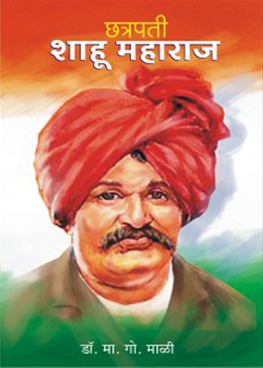 Born in the Ghatge family of Kagal in Kolhapur district, Shahu Maharaj was given the name Yashwantrao.
Born in the Ghatge family of Kagal in Kolhapur district, Shahu Maharaj was given the name Yashwantrao.
After the death of Shivaji IV, the king of Kolhapur Princely State, the young child Yashwantrao was adopted by Anandibai, the King’s widow, and subsequently coroneted King in 1894.
His rule in the period 1894 to 1922, lasting 28 years, is an important chapter in the history of Maharashtra.

During his reign, Shahu Maharaj gave special importance to the education of the masses and introduced several programs for them.
He started separate hostels in Kolhapur for students from the Maratha, Lingayat, Panchal, Jain, Muslims, Shimpi, Devadnya, Vaishya, Dhor-Chambhar and Nabhik communities and the Miss Clark Boarding especially for the students from the untouchable (socially quarantined) communities. He offered scholarships to the needy and intelligent students from the backward castes so that they could continue their education. He made primary education compulsory and free for all in his Princely State. His royal decree held up the cause of women’s education. To abolish untouchability, he stopped the cruel system followed by many institutions to hold separate schools for the upper and lower castes in 1919.
He started Patil schools so that village heads could be good administrators.
In times when the study of Vedic literature was considered a domain of the Brahmins (higher caste Pundits), he established Vedic schools that taught the Vedas to the masses and Sanskrit schools for the propagation of the Sanskrit language.
He vehemently opposed caste discrimination and took many steps to abolish untouchability. He introduced reservation for the untouchables in government jobs. He issued a royal decree in his Princely State to treat all humans equal and to give equal access to the untouchables to public utilities like common wells, schools, hospitals and common buildings. His commitment to abolish untouchability was such that he was even ready to give up his throne for the service of the dalit or lower class people.
He legalised inter caste marriages and discontinued the hereditary tenures (Watan) of revenue collectors (Kulkarni), infamous for exploiting the masses, as also the Mahar tenures that enslaved the Mahars (a lower caste).
In 1917 he legalised remarriages and widow remarriages in his Princely State. He also introduced a law banning the practice of Devdasi (a tradition where a girl is offered to God).
Rajarshi Shahu is considered one of the leaders of the anti-Brahmin movement. He strived for giving the masses and lower class communities equal participation in political power. In 1916, he established the Deccan Rayat Association in Nipani with the objective of securing political rights for the non-Brahmins. He toured Maharashtra extensively and held public meetings to promote the cause of the anti-Brahmin movement. The struggle over the right to recite the Vedas occurred in Rajarshi Shahu’s time. This struggle created a storm in the social life of Maharashtra, and gave birth to the Satyashodhak (truth finding) movement.
Rajarshi Shahu implemented a number of .
projects in his Princely State,
- like establishing the Shahu Chhatrapati Spinning and Weaving Mill, Shahupuri market, a market for jaggery, construction of the Radhanagari dam and co-operative societies for farmers.
- He made credit available to the farmers and backed research to modernize agriculture.
- To increase the yield of cash crops and the use of technology, he established the King Edward Agricultural Institute.
- These were his experiments in the areas of agriculture, co-operatives and industry that yielded high benefits for his subjects.

He patronized and encouraged many artists from the fields of music, cinema, fine arts and folk art. He supported and patronized a few writers and researchers too.
He helped Babasaheb Ambedkar for his education and for his newspaper, the Muknayak.
He provided financial aid to gymnasiums and wrestling pitches for instilling health consciousness amongst the youth and he brought prestige to the sport of wrestling.
It is because of these efforts that Kolhapur is known as the Pandharpur (one of the most important pilgrimage places) of wrestling.
The positive effects of his work in the cultural, social, political, educational, industrial and agricultural spheres are seen all over Maharashtra. Despite being a king of the Kolhapur Princely State, he was a democratic ruler.
Dr. Ambedkar appropriately described him as the ‘Pillar of Social Democracy’.
It’s because of his seminal contribution that he was conferred the title Rajarshi by the Kurmi warrior community from Kanpur.
This progressive visionary passed away on 6th May 1922 in Mumbai.
